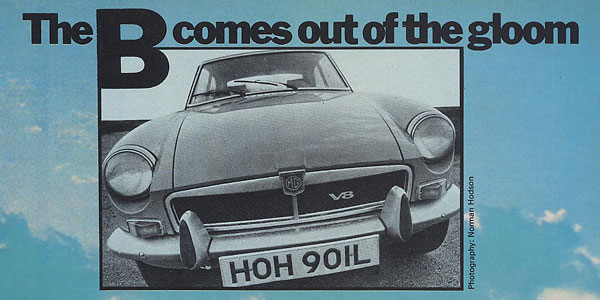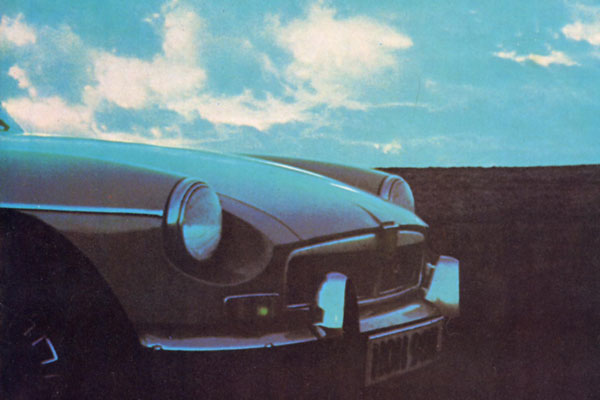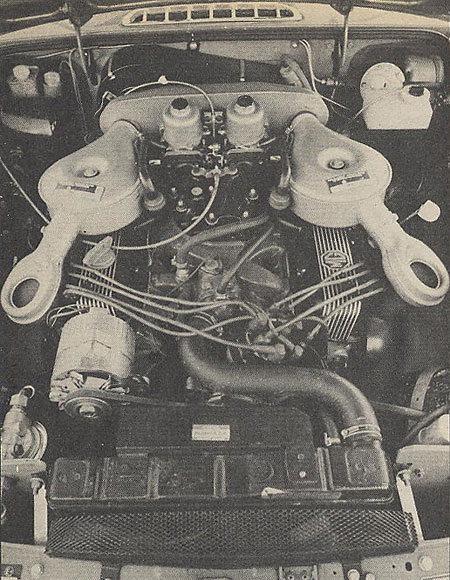�

�
The B Comes Out of the Gloom
��
as published in BritishV8 Magazine, Volume XVI Issue 2, October 2008�
�
Re-printed unedited by exclusive permission of "Cars and Car Conversions".
�
This article originally appeared in their issue for February 1974.�
�
by: Fred Game
�
photos by: Norman Hodson
�
�
The trouble with the MGB is that time ran out for it some years back. Nice looking �
car, good and solid, dependable, value for money and really quite economical. But �
in no way a sports car. The rot set in during the late sixties when saloon cars �
started to go quickly and even went round corners without too much of the wrong �
kind of dramatics. Now we've reached the stupid situation where almost any two �
litre family hack is quicker than the 1.8 litre MG. Hardly a prospect to encourage �
sales for a sports car bearing the famous octagon badge.�
�
A morale booster was needed, and drivers cried out for more power. What about the �
V8 Rover engine, they said, and the most enterprising Ken Costello even set up a �
small production line producing his own V8 B's. But no word from sleepy Abingdon �
where MG's have been made since the old days of sidescreens and wire wheels. Then �
it came. This summer the MGB GT V8 was announced by British Leyland. Closed version �
only, very limited production, and not for export - not even to the sports car �
demanding U.S. market. Externally exactly the same as the smaller engined model �
(which continues in production) but a very different motor under the bonnet. No �
likely disaster like the ill-fated MGC, but a flagship for the fleet, the performance �
of which promises to keep the MG name up in the front row of the fast car grid and �
also a car which in no doubt will in its own way encourage sales of the lower �
powered version.�
�
But is it enough? Should the V8 have had a new body, or is this just an interim move? �
How does it go? Is it the 240Z beater it looks? And what does a former 1.8 B owner �
think of it? Fred Game (who says his car was bored to 2.1 litres anyway) investigates �
overleaf.�
�
MGB GT V8 is one hell of a mouthful, in fact it's likely to give you cramp �
in your vocals if you try and say it too quickly. In this day and age of type number �
model classification, where the top prestige car in the performance range from one �
of our major manufacturers is given a top-heavy suffix, such as "Super de Luxe GT �
Special Le Mans Superleggerra S-type GXL Monza Tiiiiii Fastback Mk.Ill" it's almost �
acceptable, or is it? �
�
When the MGA became an MGB, there was good reason, like a different shell and a bigger �
engine. The origins of the 'C' undermined the principle a little as the only changes �
were the installation of a seven-bearing lorry engine and Morry Minor front suspension. �
These revolutionary changes did not alter the basic characteristics of the 'B' to any �
extent. It still understeered chronically in the wet and despite the extra power the �
big mill was just not responsive enough to encourage anything other than leisurely �
driving, at least not safely. Putting the V8 in made the car totally different, a �
quick touch of the proverbial chalk and cheese syndrome, would you believe, definitely �
a case for a new letter. But no, good old BLMC forgot that the 'C' ever existed, stuck �
with the 'B' suffix (which would have been logical if the MGC never had made the �
production line) and stuck in the V8 qualification.�
�
Which is all a bit of a downer, 'cos as I said, it's a different animal altogether - �
providing you forget things like the rather antiquated interior, seating position and �
haphazardly situated controls. �
�

�
� However, more of the personal impressions bit anon; now's the time for a quick delve � into the mechanical complexity of the thing. Having been shown the way to install the � Rover V8 into a 'B' shell by Ken Costello (who still makes them himself by the way, � down in Farnborough, Kent) the design staff at BLMC could have been forgiven for merely � copying Ken's methods completely. But they didn't. Rather than use the 'B' gearbox and � drive train, they opted for the C-type components, with a few mods thrown in for good � measure. For starters, the casing itself was redesigned so that a larger clutch - mit � ballrace release bearing instead of the more normal carbon thrust - could be incorporated, � whilst the insides also came in for a bit of attention, with stronger and higher � intermediate ratios to make full use of the extra torque available, Of course, all � forward gears have the modern luxury of synchromesh and the standard fitting overdrive � operates on top only. The 'C' rear axle pulls a 3.91 to 1 crownwheel and pinion, rather � than the 'little' version's 3.07 to 1.�
��

�
�
�
Suspension is as per the normal 'B' with coil springs and unequal length wishbones �
at the front and half elliptic leaf springs at the rear, although they are uprated �
to cope with the extra power. Brakes retain the time honoured disc/drum layout and �
have a servo fitted as standard equipment to help the leg muscles a bit. Actual �
dimensions for these all important goodies are 10.7 inches diameter for the discs �
and 10 inches diameter for the drums. The very attractive wheels are manufactured �
by Dunlop on their composite principle ie, alloy centres with steel rims and carry �
175 x 14 tyres.�
�
Engine power output is a resounding 137 bhp (well, that's pretty resounding when you �
consider it in relation to the 1.8 litre's efforts) developed at 5000 rpm. The torque �
figure is more impressive at 193 lb ft at a leisurely 2900, but then there are 3528 �
good reasons why it should be that high. They're the number of cc's, twit! Main mods �
to the unit itself, primarily to get it to fit under the bonnet without the need for �
MGC type unsightly bulges, centre around a swept-back manifold to take the twin HIF 6 �
SU carbies rather than the old penthouse shaped (how nice!) effort used on the Rovers. �
In appearance - if nothing else - this manifold resembles the one that Mr Costello �
uses to mount a 45 DCOE Weber on, that could be one way of getting back some of the �
original Rover 3500 'S's 184 bhp that used to be developed before detuning and the �
fitting of even more horrible anti-tox stuff. Still, my 600 odd test miles did return �
what I considered to be a fair fuel consumption of 19.5 miles per gallon. But what of �
the actual performance figures, like what do you get in terms of velocity out of the �
extra availability of neddies? From parked to 60 mph (you do remember 60 mph don't you?) �
takes just on 8 seconds, which is 3 secs quicker than the four-banger, whilst the top �
speed climbs from 210% of the present overall speed limit to 251% in mph that's 105 �
to 125.5.�
�
�
Enjoying this article? Our magazine is funded through the generous support of readers like you!
�
To contribute to our operating budget, please click here and follow the instructions.
�
(Suggested contribution is twenty bucks per year. Feel free to give more!)�
�
Moving on to the body, it's really just a case of "you've seen it all before", but for �
the wheels and Rover V8 badges there is no noticeable difference between the 3.5 and �
1.8 litre unless you look for the little notes of subtleness like the tinted glass and �
the door mounted mirrors.�
�
Inside, the subtle change note is continued, with comfortable, cloth covered seats �
that unfortunately offer little in the way of side support, smaller speedo and rev �
counter to allow for the larger shroud that covers the energy absorbing steering column �
and the switchgear that now resides in that area, and a horrible leather-rim steering �
wheel without holes in the spokes that is a true study in grotness. Why is it that MGA's, �
B's and C's always have awful steering wheels fitted as standard? Don't the designers �
ever use the results of their artistry to point a car? Perhaps they're all wizards at �
the handbrake art, a factor which I don't believe as the one in my test car (and the �
one in the 'B' that I owned) was so effective that it might as well have been left out.�
�

�
�
�
Once I started to drive the car, most of the inherent faults could be forgotten, �
despite the unfriendly comments made previously. Really. I like the 'B', otherwise �
I wouldn't have bought one a couple of years ago, would I? In 1.8 litre form, an �
MGB is a smooth, fast touring two-seater, capable of covering large distances at �
high average speeds without reducing the driver to a quivering, overtired zombie. �
With the V8 urge the plus points remain, and in addition there is enough acceleration �
to outdrag most of the saloons that find it easy to pee over the 4-cylinder device, �
a factor that might not sound important, but one that I used to find personally �
nauseating.�
�
But the noise! My own car was a 1.8 convertible, and I expected it to be bad as far �
as wind noise was concerned. I was therefore pleased that mine didn't suffer very �
much from flapping leathercloth and rattling hood stays. However, each time I �
exceeded 60 mph with the GT (this was before the 50 limit) oh dear! No matter what �
I did - opening the quarterlights, closing them, opening the windows, trying them �
at different levels - nothing but nothing would lower the wind noise enough to be �
able to hear the radio at anything less than full volume. I checked the door �
alignment and the window fitting without finding any obvious faults, so I can only �
assume that all 'B' GT's are bad in this respect.�
�
Previous experience of 'B' brakes fitted with a servo taught me to respect them and �
the V8 was no different. One prod on the appropriate pedal gives a genuine "shit, �
I've hit a brick wall" effect, �
�
Handling is really a case of what you make of it. The well chosen gear ratios, ample �
power and good brakes all help to make entering and leaving corners a quicker and �
simpler process than it has been with previous MG's, using the throttle pedal sensibly �
also means that the understeering tendencies referred to earlier can be countered �
which makes the car what you might loosely term as neutral (i.e. it will understeer �
in and oversteer out of almost any sort of bend). �
�
At £2293.96 the MGB GT V8 is not a cheap car, beating a 3-litre Capri by the best part �
of £500, but then people don't buy 'B's as alternatives to Capris, do they? �
�
� BritishV8 Magazine has assembled the largest, most authoritative collection of MG � "MGB GT V8" information you'll find anywhere. Check it out! � Access our � MGB GT V8 article index by clicking here.�
�
